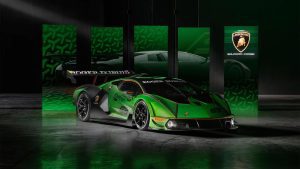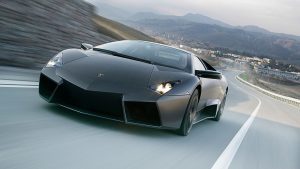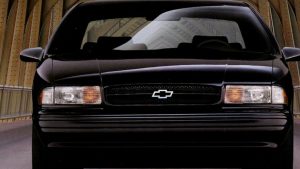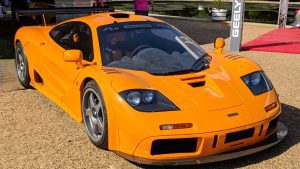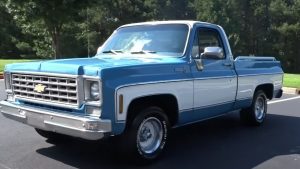
Rimac Nevera - Source Rimac Media
Table of Contents
Introduction

Even before we move into the Rimac Nevera, let’s get the basics right. The word “Rimac” is pronounced as Ree-Muts, referring to the name of the brand’s founder, Mate Rimac. Having converted his BMW E30 to an electric car at the age of 19, Mate was all in for EVs even before the brand was established. With Porsche Engineering Group later buying a 10% stake in the brand, Rimac was on its way to making cars that would defy the laws of physics.
Just in case you haven’t stumbled across the name by far, the Rimac Nevera, based on the C_Two concept, is an all-electric sports car featuring four carbon-sleeved AC synchronous motors that power all four wheels independently. The result? A 1,914 HP hypercar with 1,741 lb-ft of torque that can shoot to 60 from a standstill in just 1.74 seconds, making it the fastest-accelerating production car ever. However, Nevera’s 0-60 isn’t the only thing on offer.
15. The Rimac Nevera Is The Fastest EV With 23 Other Records
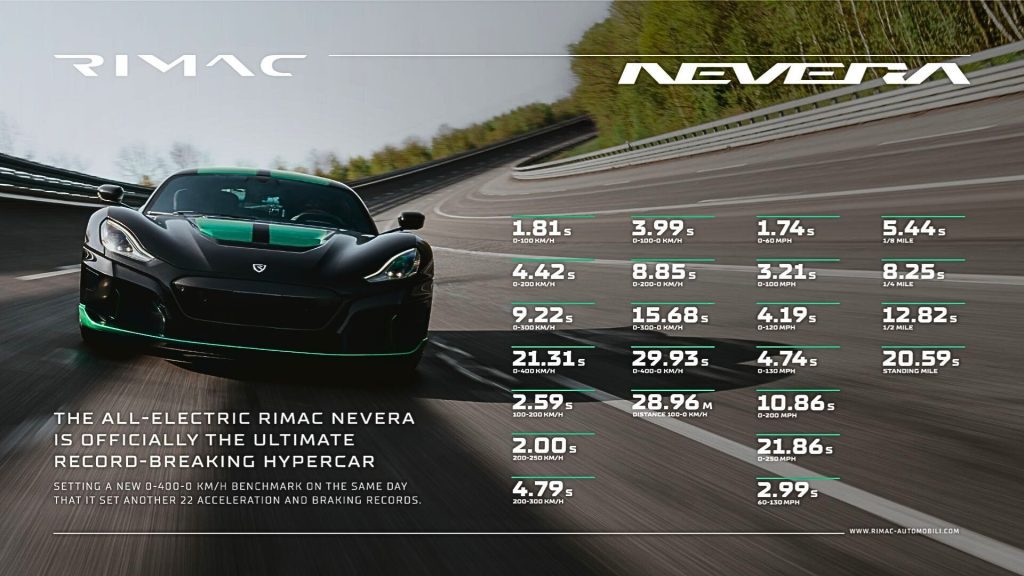
With manufacturers beating speed records frequently, Rimac decided to join the club by setting the record for the fastest EV ever produced. While the car is limited to 219 MPH, minor tweaks allow the Nevera to hit a top speed of 256 MPH. Although not as fast as some gas-chugging hypercars, the Nevera sits on top of the EV table, holding 23 other performance records in its bag.
The Nevera in 2023 Goodwood Festival of Speed also set the record for the fastest production EV clocking at 49.32 seconds. Along with this, it is officially the fastest backwards going car. You read that right, the Nevera in 2023 also claimed the Guinness world title of fastest car driving backwards with a speed of 171.34 mph.
14. Has An Integrated AI Driving Coach

Not everyone develops a strong and professional driving sense, and while some are quick learners, others might need a bit more time. Regardless, the Nevera features the world’s first AI driving coach, which uses radar, lidar, and 12 ultrasonic sensors along with the nine onboard cameras to monitor the driver and their inputs.
The AI coach gives suggestions like when to brake and the kind of line to maintain on a track, helping the driver improve their skill set. The Nevera can also drive itself on select tracks around the world at its full potential to show the driver both the car’s potential and the kind of lines to maintain.
13. Higher Structural Rigidity Than An LMP1 Car
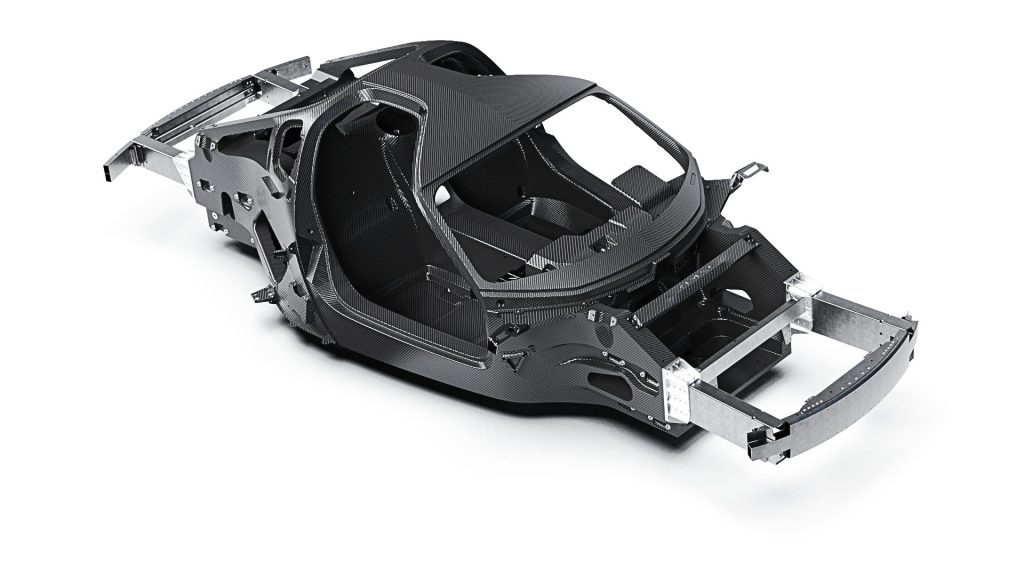
Apart from the front and rear crumple zones, the entire body of the Nevera is constructed using what’s known as the automaker’s cannabis, carbon fiber, because it makes the car feel lighter.
Being stronger than metal, the structure gives the Nevera a rigidity of 70,000 newton-meters. Just to give context, LMP1 cars that run endurance races have less structural rigidity than the Nevera.
12. Play With Torque On The Go

The interior of the Nevera features a lot of dials that have a tiny screen integrated into them. One of those dials helps the driver control the amount of torque being split between both the front and rear wheels.
In short, although the car comes as an all-wheel-drive vehicle, it’s possible to switch all the torque to the front wheels, or if you wish to drive like Takumi from Initial-D, feel free to switch the torque completely to the rear wheels.
11. Croatian Car With An Italian Cousin
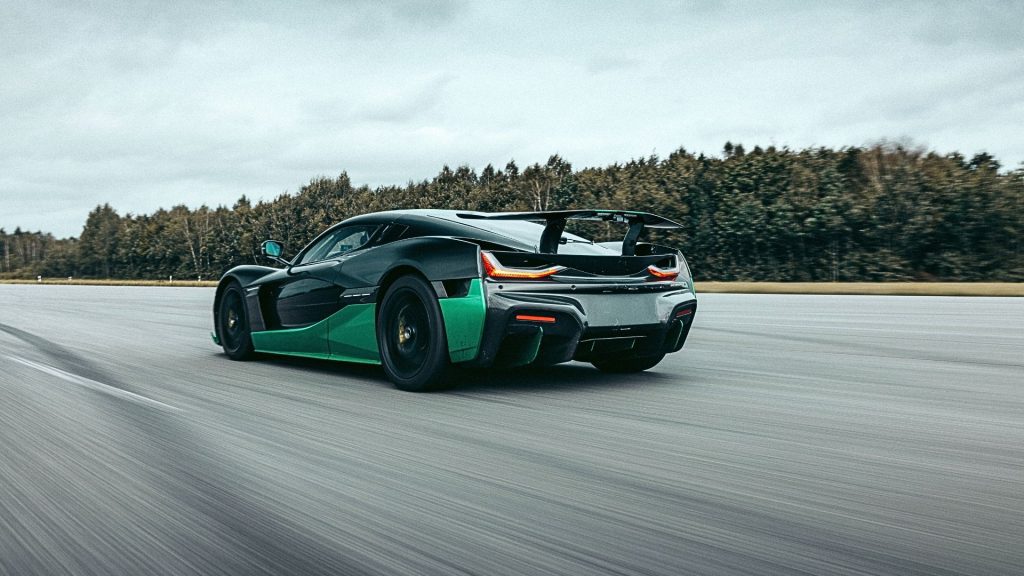
While it is true that the Nevera is a unique car, there is another similar car from Italy. They are so similar that only their designs and names vary. The car in question here is the Pininfarina Battista, which is the Italian design firm’s first-ever in-house model.
Since it was built in partnership with Rimac, the underpinnings, like the chassis and the battery pack, were lifted straight from the Nevera. However, anything from Italy needs to be expensive, and hence, the Pininfarina Battista is priced slightly higher than the Nevera.
10. It is Possible To Charge The Car To 80% In Just 25 Minutes
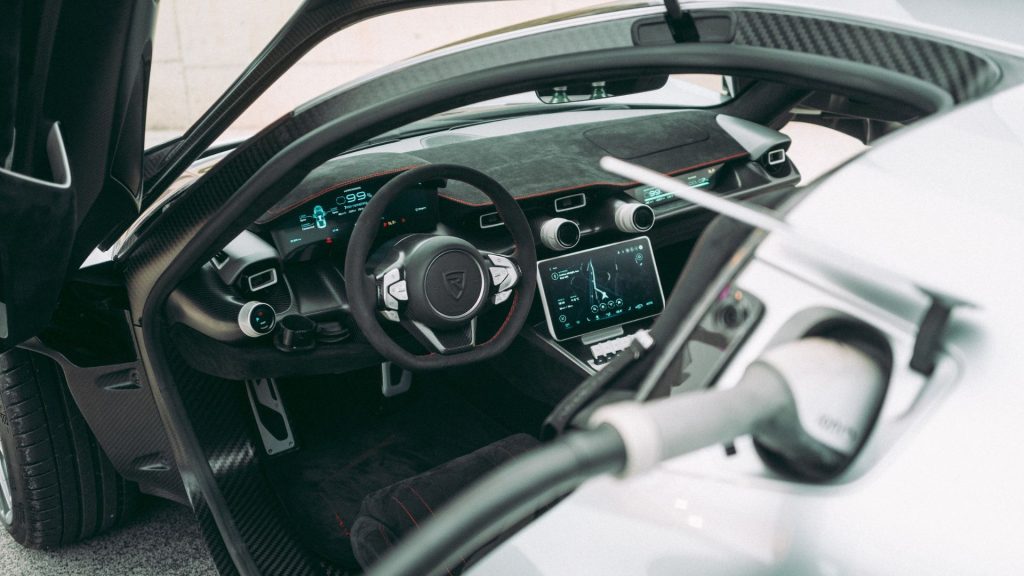
Yes, you read that right, but there’s a catch. It is technically possible to charge the car to 80% capacity in 25 minutes using 350kW Halo chargers. As that might sound pretty impressive, people working at Rimac Automobili seem to disagree. The Rimac is working on developments in charging technology which would allow the Nevera to charge at 500 kW dropping the 0 – 80% charging time to 19 minutes (approx)
9. A Hypercar That Was Actually Crash Tested
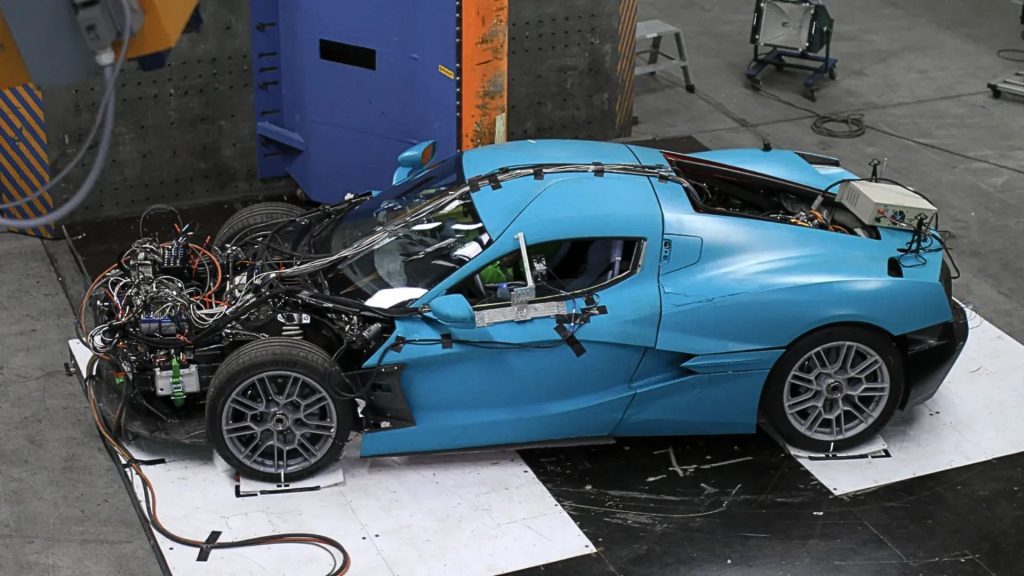
While crash testing a regular car is normal to pass homologation, expensive car manufacturers at times skip it. Another option they have is to conduct something called a crash simulation, where they use software to detect how a car would fare in the event of a crash.
Rimac, however, chose to do things the traditional way and ended up putting not 1 but 9 fully functional cars through various crash tests to ensure that their cars were safe to be driven anywhere in the world. It was also found out from the tests that the Nevera was twice as strong as any other hypercar on the market.
8. Only 150 Units Will Be Ever Produced
All hypercars are feats of engineering and use materials that are expensive to source and manufacture. Hence, these cars are produced in limited numbers.
The Rimac Nevera will see a total production run of 150 units, with all slots already sold out. The brand manufactured the first set of 50 cars in 2022 and is expected to end production at the end of 2024.
7. A Historical Reference In Its Design

While Rimac has proudly represented its country by mentioning that the car was designed, engineered, and manufactured in Croatia, there is another cultural reference hidden in the car. The side aero section on the doors of the Nevera has a design that narrows down at an angle towards the wheel arches. This design has been inspired by a cravat.
While some might wonder what a necktie has to do with Croatia, it is said that they were worn by the Croatian army during the French War. Soldiers tied a red piece of silk around their necks, with the loose end narrowing down towards the neck and held by a knot. The French named it the Cravat, derived from the word Croat.
6. The Largest Carbon Fiber Monocoque

Like how regular performance cars are constructed using aluminum or steel along with carbon fiber, the Rimac Nevera skips the unnecessary metal and goes all-out carbon because the Nevera is no regular performance car.
The result was the largest carbon fiber monocoque to have ever been featured on any car. This is also the reason why the car is twice as strong as any other car in its segment.
5. A Rather Special First Delivery

As special as the car is, Rimac could not have hoped for a first customer delivery to be any better than this. The first production car named #001 was handed over to Nico Rosberg, the 2016 F1 World Drivers Champion who raced for Mercedes-AMG Petronas Motorsport. Nico, apart from being a brilliant racer, is known to have an immaculate taste in cars and has become the first customer of the Rimac Nevera.
4. You Don’t Need Special Invites To Buy The Nevera

While we hear stories about manufacturers restricting anyone from just walking in and buying their cars and demanding they own other models in order to be invited, Rimac just kept it straight and simple. Anyone with the money can buy a Rimac Nevera, but unfortunately, “anyone” wouldn’t have $2.2 million lying in their bank account.
3. Houses The Largest Battery Pack For A Performance Car

With EVs getting more advanced and powerful, the technology and components have only gotten better. Gone are the days when EVs were made fun of, and with manufacturers like Tesla showcasing the true potential of battery-powered vehicles, other manufacturers have been open to adopting electric powertrains.
Rimac, however, takes things to a whole new level as it packs in 1,914 horsepower, and all that power comes from its battery. Since the figure is so high, it’s obvious that the battery pack would be enormous. The car holds a massive 120 kWh unit that comprises of 6,960 cells with 21,700 format. This is the largest in a performance car, with only Rivian and Hummer beating it, as they both make heavy-duty trucks and SUVs.
2. Impressive Range For A Hypercar
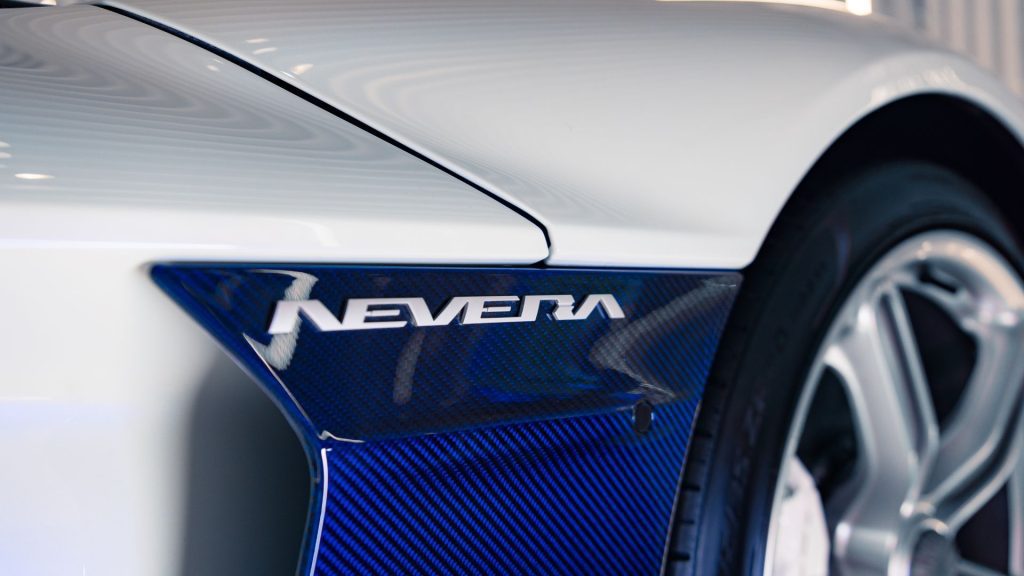
High-performance vehicles are not considered to push out good range figures. The Rimac Nevera is an almost 2,000 HP monster, so it is even pointless to think about the range when buying the car. Or is it?
The Rimac Nevera can cover a total of 287 miles on a single charge, as confirmed by the EPA. While that isn’t as high as what Tesla and Lucid offer with its models, it still stands higher than a lot of mass-produced EVs on the market.
1. True Definition Of “Built From The Ground Up”

When a car is manufactured, they use components and parts from other brands in order to cut costs. Even the Bugatti Chiron’s steering wheel design is inspired by the Audi R8, as Bugatti was under the Volkswagen Group, which also owns Audi.
However, the Rimac Nevera is truly unique and was built from scratch with every component, from the wheels, screens, battery, and carbon fiber monocoque, made in-house. The only components on the Nevera that are manufactured by Rimac are probably the tires and the AC unit.


